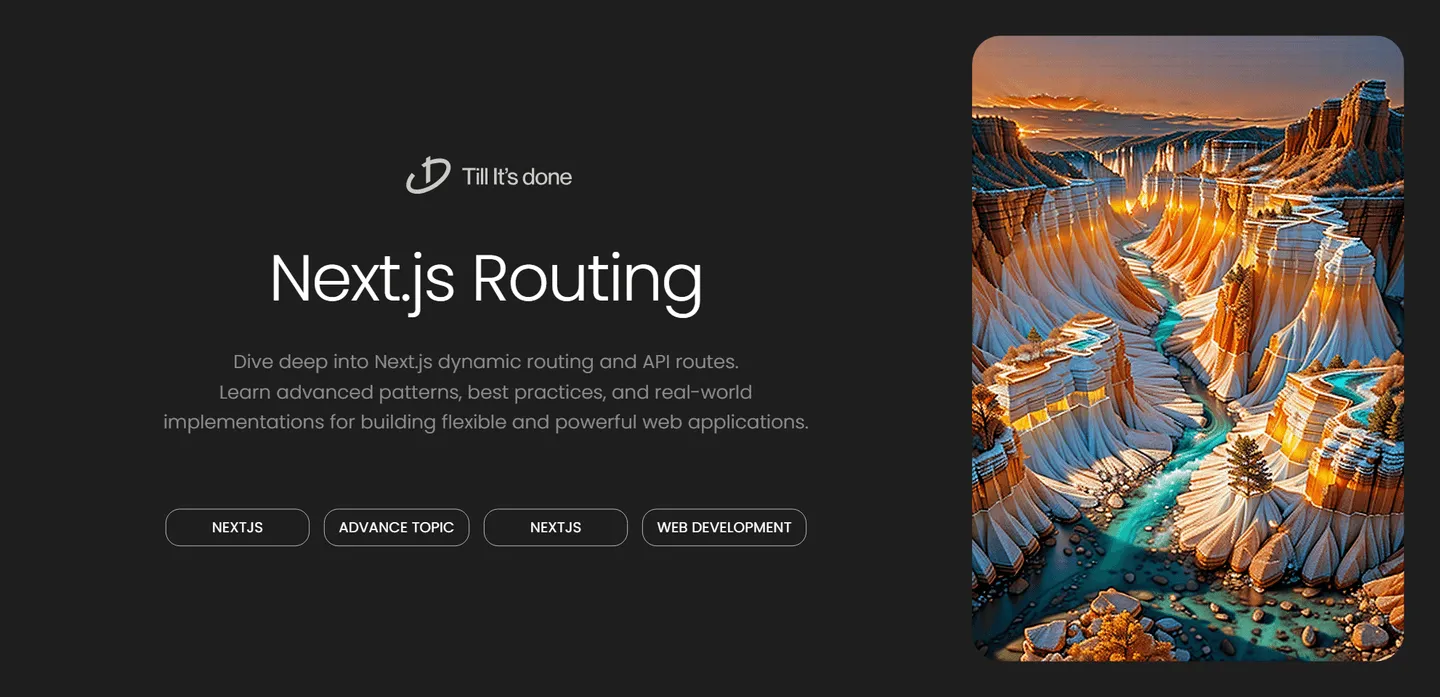- Services
- Case Studies
- Technologies
- NextJs development
- Flutter development
- NodeJs development
- ReactJs development
- About
- Contact
- Tools
- Blogs
- FAQ
Mastering Dynamic Routing and API Routes in Next.js
Learn advanced patterns, best practices, and real-world implementations for building flexible and powerful web applications.

Mastering Dynamic Routing and API Routes in Next.js

In today’s web development landscape, creating dynamic and efficient applications is crucial. Next.js, the popular React framework, offers powerful features for handling complex routing scenarios and building robust APIs. Let’s dive deep into mastering dynamic routing and API routes in Next.js.
Understanding Dynamic Routes
Dynamic routing is like creating a flexible blueprint for your pages. Instead of defining every possible URL manually, you can create templates that adapt to different content. Think of it as creating a single master key that can open multiple doors.
For example, let’s say you’re building a blog platform. Rather than creating separate pages for each blog post, you can create a dynamic route:
export default function BlogPost({ post }) { return ( <article> <h1>{post.title}</h1> <div>{post.content}</div> </article> );}
Advanced Dynamic Route Patterns
Next.js supports various dynamic route patterns that can handle complex scenarios:
Catch-all Routes
Using […param] syntax, you can capture multiple URL segments. This is perfect for hierarchical data structures or nested categories:
// Matches /docs/features// Matches /docs/features/routing// Matches /docs/features/routing/dynamicOptional Catch-all Routes
Adding the double brackets [[…param]] makes the catch-all segments optional, providing even more flexibility in your routing structure.
Working with API Routes

API routes in Next.js allow you to build your backend API right within your application. They live in the pages/api directory and automatically become API endpoints.
Here’s a real-world example of an API route handling user authentication:
export default async function handler(req, res) { if (req.method !== 'POST') { return res.status(405).end(); }
try { // Handle authentication logic const { email, password } = req.body; // Authenticate user... res.status(200).json({ success: true }); } catch (error) { res.status(400).json({ error: error.message }); }}Best Practices and Performance Tips
- Always validate dynamic parameters to ensure they match your expected format
- Implement proper error boundaries for when dynamic routes fail to load
- Use middleware for common functionality across multiple API routes
- Leverage Edge Functions for globally distributed API endpoints
- Implement proper caching strategies for both dynamic routes and API endpoints
When building complex applications, remember that dynamic routes and API routes can work together seamlessly. For instance, you can fetch data through an API route and use it to populate your dynamically routed pages.
Conclusion
Mastering dynamic routing and API routes in Next.js opens up endless possibilities for creating sophisticated web applications. Whether you’re building a blog, e-commerce platform, or complex web application, these features provide the flexibility and power needed for modern web development.

 สร้างเว็บไซต์ 1 เว็บ ต้องใช้งบเท่าไหร่? เจาะลึกทุกองค์ประกอบ website development cost อยากสร้างเว็บไซต์แต่ไม่มั่นใจในเรื่องของงบประมาณ อ่านสรุปเจาะลึกตั้งแต่ดีไซน์, ฟังก์ชัน และการดูแล พร้อมตัวอย่างงบจริงจาก Till it’s done ที่แผนชัด งบไม่บานปลายแน่นอน
สร้างเว็บไซต์ 1 เว็บ ต้องใช้งบเท่าไหร่? เจาะลึกทุกองค์ประกอบ website development cost อยากสร้างเว็บไซต์แต่ไม่มั่นใจในเรื่องของงบประมาณ อ่านสรุปเจาะลึกตั้งแต่ดีไซน์, ฟังก์ชัน และการดูแล พร้อมตัวอย่างงบจริงจาก Till it’s done ที่แผนชัด งบไม่บานปลายแน่นอน  Next.js สอน 14 ขั้นตอนเบื้องต้น: สร้างโปรเจกต์แรกใน 30 นาที เริ่มต้นกับ Next.js ใน 14 ขั้นตอนเพียงแค่ 30 นาที พร้อม SSR/SSG และ API Routes ด้วยตัวอย่างโค้ดง่าย ๆ อ่านต่อเพื่อสร้างโปรเจ็กต์แรกได้ทันทีที่นี่
Next.js สอน 14 ขั้นตอนเบื้องต้น: สร้างโปรเจกต์แรกใน 30 นาที เริ่มต้นกับ Next.js ใน 14 ขั้นตอนเพียงแค่ 30 นาที พร้อม SSR/SSG และ API Routes ด้วยตัวอย่างโค้ดง่าย ๆ อ่านต่อเพื่อสร้างโปรเจ็กต์แรกได้ทันทีที่นี่  วิธีสมัคร Apple Developer Account เพื่อนำแอปขึ้น App Store ทีละขั้นตอน อยากปล่อยแอปบน App Store ระดับโลก มาอ่านคู่มือสมัคร Apple Developer Account พร้อมเคล็ดลับ TestFlight และวิธีอัปโหลดที่ง่ายในบทความเดียวนี้ได้เลย
วิธีสมัคร Apple Developer Account เพื่อนำแอปขึ้น App Store ทีละขั้นตอน อยากปล่อยแอปบน App Store ระดับโลก มาอ่านคู่มือสมัคร Apple Developer Account พร้อมเคล็ดลับ TestFlight และวิธีอัปโหลดที่ง่ายในบทความเดียวนี้ได้เลย  TypeScript Interface คืออะไร? อธิบายพร้อมวิธีใช้และข้อแตกต่างจาก Type เรียนรู้วิธีใช้ TypeScript Interface เพื่อสร้างโครงสร้างข้อมูลที่ปลอดภัยและเข้าใจง่าย พร้อมเปรียบเทียบข้อดีข้อแตกต่างกับ Type ที่คุณต้องรู้ ถูกรวมเอาไว้ในบทความนี้แล้ว
TypeScript Interface คืออะไร? อธิบายพร้อมวิธีใช้และข้อแตกต่างจาก Type เรียนรู้วิธีใช้ TypeScript Interface เพื่อสร้างโครงสร้างข้อมูลที่ปลอดภัยและเข้าใจง่าย พร้อมเปรียบเทียบข้อดีข้อแตกต่างกับ Type ที่คุณต้องรู้ ถูกรวมเอาไว้ในบทความนี้แล้ว  Material-UI (MUI) คืออะไร อยากสร้าง UI สวยงามและเป็นมืออาชีพในเวลาอันรวดเร็วใช่ไหม มาทำความรู้จักกับ Material-UI (MUI) ที่ช่วยให้คุณพัฒนาแอปพลิเคชันบน React ได้ง่ายและดูดีในทุกอุปกรณ์
Material-UI (MUI) คืออะไร อยากสร้าง UI สวยงามและเป็นมืออาชีพในเวลาอันรวดเร็วใช่ไหม มาทำความรู้จักกับ Material-UI (MUI) ที่ช่วยให้คุณพัฒนาแอปพลิเคชันบน React ได้ง่ายและดูดีในทุกอุปกรณ์  เปรียบเทียบ 3 วิธีติดตั้ง install node js บน Ubuntu: NVM vs NodeSource vs Official Repo แบบไหนดีที่สุด? เรียนรู้วิธีติดตั้ง Node.js บน Ubuntu ด้วย NVM, NodeSource หรือ Official Repo เลือกวิธีที่เหมาะกับความต้องการของคุณ พร้อมเปรียบเทียบ เพื่อการพัฒนาที่มีประสิทธิภาพ!
เปรียบเทียบ 3 วิธีติดตั้ง install node js บน Ubuntu: NVM vs NodeSource vs Official Repo แบบไหนดีที่สุด? เรียนรู้วิธีติดตั้ง Node.js บน Ubuntu ด้วย NVM, NodeSource หรือ Official Repo เลือกวิธีที่เหมาะกับความต้องการของคุณ พร้อมเปรียบเทียบ เพื่อการพัฒนาที่มีประสิทธิภาพ! พูดคุยกับซีอีโอ
We'll be right here with you every step of the way.
We'll be here, prepared to commence this promising collaboration.
Whether you're curious about features, warranties, or shopping policies, we provide comprehensive answers to assist you.


